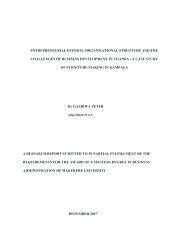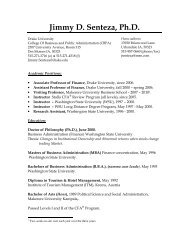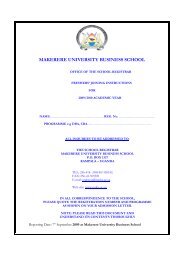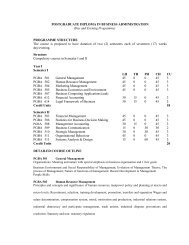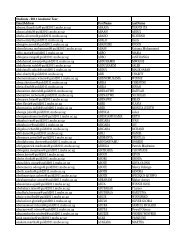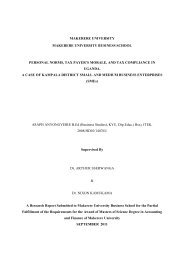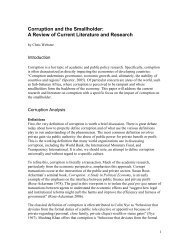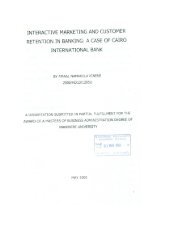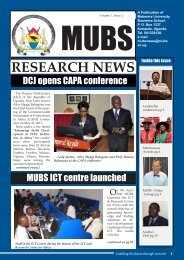13th Annual International Management Conference Proceeding
13th Annual International Management Conference Proceeding
13th Annual International Management Conference Proceeding
You also want an ePaper? Increase the reach of your titles
YUMPU automatically turns print PDFs into web optimized ePapers that Google loves.
The intrapreneur is really the corporate equivalent of the entrepreneur. We could also call him the corporate<br />
or internal entrepreneur. The intrapreneur could be the non–owner manager, business unit manager, Chief<br />
Executive Officer or Chief Operating Officer. He could be the Chief Information Officer who transforms<br />
his unit from being an information technology (IT) <strong>Management</strong> Support Unit to being a Strategic Business<br />
Unit, offering IT based products and services on a commercial basis in – house and to third parties.<br />
Intrapreneurship is entrepreneurship within an existing organisation. It can be defined as a process by which<br />
individuals inside organisations pursue opportunities without regard to the resources they currently control,<br />
and as doing new things and departing from the customary to pursue opportunities (Vesper, 1990).<br />
Intrapreneurship can also be conceptualised in terms of the pursuit of creative or new solutions to challenges<br />
confronting the firm, including the development or enhancement of old and new products and services,<br />
markets, and administrative techniques and technologies for performing organisational functions. In this<br />
context, changes in strategy, organisational structures and systems, and methods of dealing with competitors<br />
may all be seen as innovations in the broadest sense of the term. Intrapreneurship means bottom-up business<br />
building, spearheaded by people who yesterday were working as line managers or employees. It is<br />
inconsistent with reengineering, downsizing, and other efficiency methodologies.<br />
Intrapreneurship has been classified by its characteristics into four dimensions: (a) new business venturing,<br />
(b) innovativeness, (c) self-renewal, and (d) proactiveness (Hisrich and Peters, 2002). New business<br />
venturing is the most salient characteristic of intrapreneurship since it can result in new business creation<br />
within an existing organisation by redefining the company's products or services and/or by developing new<br />
markets. In large corporations, it could also include formation of more formally autonomous or semiautonomous<br />
units or firms. For all organisations regardless of size, the new business-venturing dimension<br />
refers to the creation of new businesses that are related to existing products or markets regardless of the level<br />
of autonomy.<br />
In contrast, the innovativeness dimension refers to product and service innovation with emphasis on<br />
development and innovation in technology. The third dimension, self-renewal, reflects the transformation of<br />
organisations through the renewal of key ideas on which they are built. This has strategic and organisational<br />
change connotations that include the redefinition of the business concept, reorganisation and the<br />
introduction of system wide changes for innovation, new strategic direction and continuous renewal of the<br />
organisation. The final dimension, proactiveness, is related to aggressive posturing and leadership relative to<br />
competitors, risk-taking, initiative taking and boldness and aggressiveness in pursuing opportunities.<br />
The impact of intrapreneurs can be felt on the corporate level or within their business unit. They go beyond<br />
being manager. They may not be partly or wholly owners of the business but get a benefit [usually in the<br />
short – term] for their performance. They should be rewarded appropriately through a performance based<br />
bonus plan i.e. tied to the bottom – line. They should have positions of authority and be decision – makers.<br />
Like wise, Intrapreneurship has been operationalised in empirical research in many diverse ways. Some of the<br />
variables used to model intrapreneurship are as follows: Innovativeness/innovation; risk taking;<br />
proactiveness; competitive aggressiveness; prior venture experience; slack resources/ resource availability;<br />
autonomy; rewards and sanctions; centralisation of decision making; specialisation; organisational support;<br />
time availability; organisational structure; organisational communication; environmental scanning;<br />
organisational values/culture; self renewal; new business venturing and ownership (Maes, 2003, Antoncic<br />
and Hisrich, 2001; Kuratko et al, 1990, Zahra 1995, 1991; Zahra and Covin, 1995). These variables refer<br />
to practices or circumstances that can in some degree be controlled by the organisation.<br />
Studies on intrapreneurship by Zahra (1991and 1999) focused on the manufacturing corporations in the<br />
USA and found that internal organisational characteristics impact on intrapreneurship. The paper also found<br />
that intrapreneurship improves performance. This paper was confirmed by Rusell and Rusell (1992) in a<br />
study of 77 strategic business units in the USA and Antoncic and Hisrich (1998) in a study of Slovenian<br />
firms. In addition, improved organisational results, usually in terms of growth and profitability, are thought<br />
to be a result of intrapreneurship (Zahra, 1991; Zahra and Covin, 1995; Antoncic and Hisrich, 1998).<br />
Smart and Conant (1994) captures not only the dynamic process in dimensions of innovation, risk-taking<br />
46



